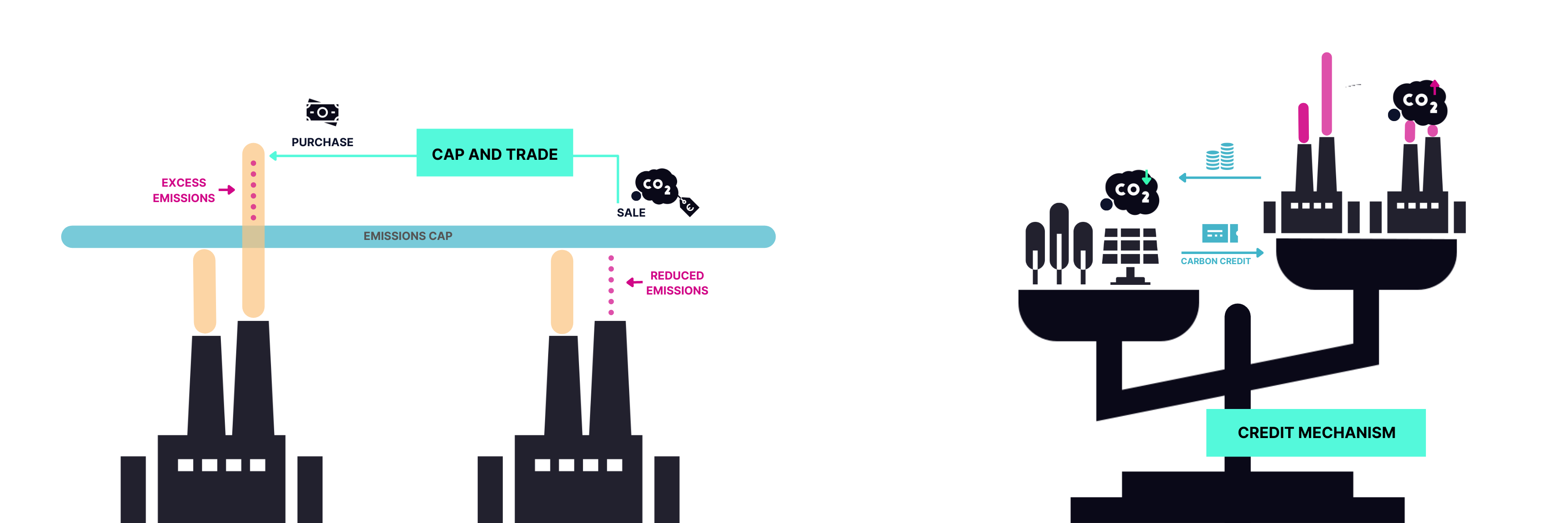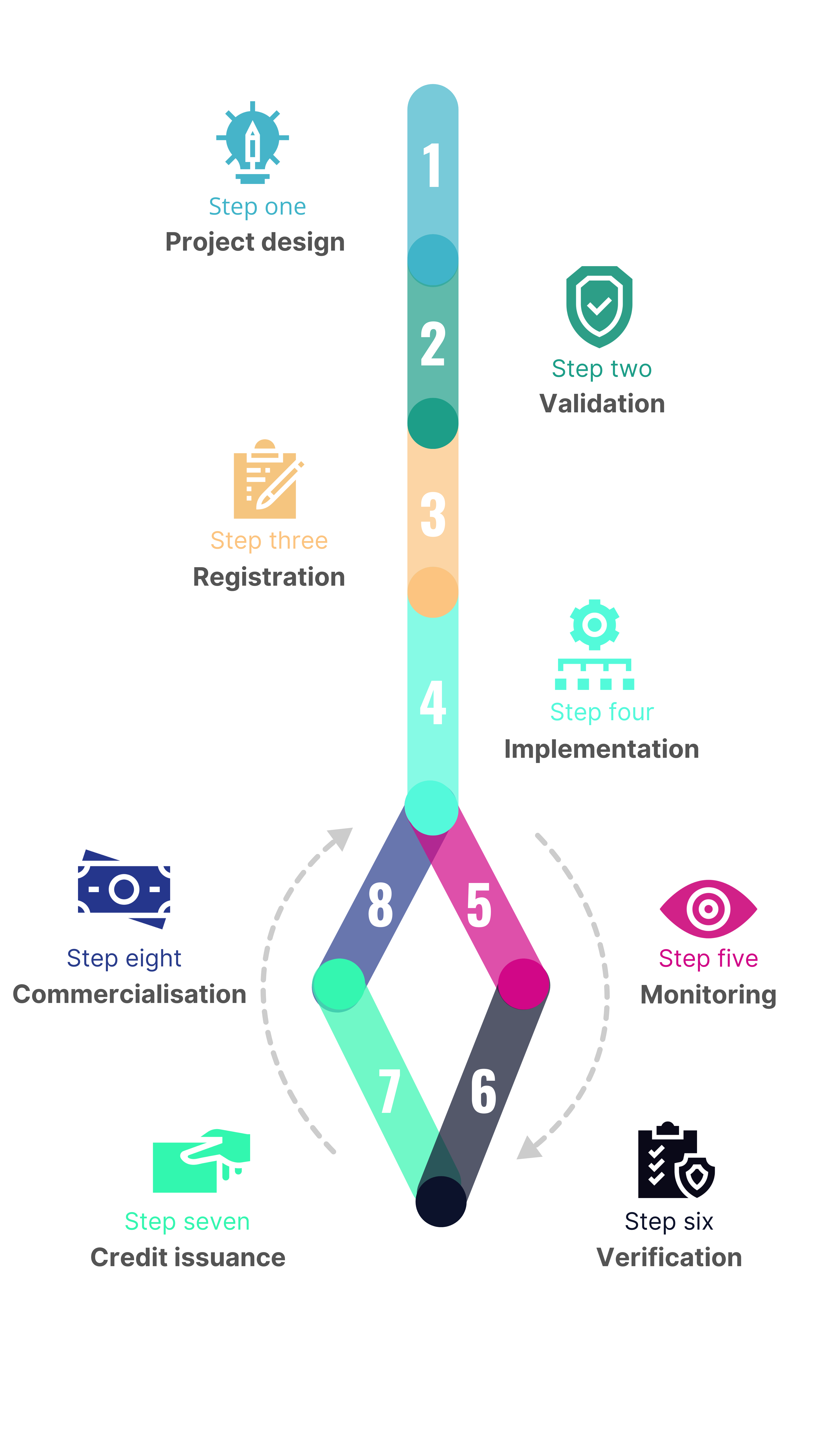Carbon markets are complex mechanisms that are meant to promote climate action but can also mask inaction. Our latest FAQ has the answers to everything you always wanted to know about global carbon markets.
For more details on current state of international carbon credit markets, you can check our latest guide: ‘Carbon Markets 101 – The ultimate guide to market-based climate mechanisms’.
Carbon markets are regarded as a tool to help tackle the climate crisis caused by the accumulation of human-emitted gases in the atmosphere by seeking to bring about emissions reductions where they are least costly. Thus, this financial system aims to reduce these greenhouse gases (GHGs) by putting a price on emissions, primarily carbon dioxide (CO2). Its premise is based on the theory that, as long as there is control over the total amount of emissions traded in the market, it does not matter to the atmosphere who buys or sells carbon credits. In practice, establishing a carbon market has a significant risk of loopholes that can result in this policy having little to no impact on reducing emissions.
There are two main types of carbon markets: cap-and-trade or emissions trading schemes and carbon crediting systemes.

Some carbon markets have positively impacted climate action, particularly those that set a hard cap on emissions, such as the EU Emissions Trading System. However, they remain flawed, and other systems have largely failed at reducing global emissions. The practice of offsetting emissions, in particular, comes with significant risks, especially around misleading claims and greenwashing.
A project developer must follow the rules of the carbon market standard under which it is seeking to register its project. While procedures can vary, they all broadly follow the following eight steps:

Yes, carbon markets are covered by Article 6 of the Paris Agreement. Under this agreement, nearly all the countries worldwide have set themselves climate targets while also establishing two new carbon markets to replace the three set up under the Kyoto Protocol.
These market mechanisms are covered under Article 6.2 and Article 6.4. The detailed rules of these mechanisms have been under negotiation since 2016. In October 2021, at COP26 in Glasgow, countries agreed to the overall rulebook for these new mechanisms, but further implementation requirements and design elements are still being negotiated.
Here is an overview of its current structure:

Carbon markets are often divided into two categories: “compliance” and “voluntary” markets.
A compliance carbon market is one that focuses on obligatory emissions targets, such as a country that wants to meet its climate target under the Paris Agreement or a company that must comply with a binding government policy requiring it to purchase a certain number of carbon credits to be able to pollute. The voluntary carbon market is tapped by companies or organisations that decide to purchase carbon credits, whether in anticipation of future obligations or, more often, as part of a corporate social responsibility and/or public relations plan.
In reality, the frontier between compliance and voluntary markets has become more and more blurry as the number of players participating in these systems has increased.
An easy example to illustrate this is the case of airlines. Under the UN’s Carbon Offsetting and Reduction Scheme for International Aviation (CORSIA), airlines face an obligation set by the government to purchase carbon offsets. At the same time, many airlines buy credits voluntarily as part of their PR campaigns. For a given credit, the carbon market will be considered “compliance” if the credit is purchased as a way of meeting the CORSIA obligation, but will be considered “voluntary” if it is purchased for other purposes. You can learn more about CORISA here.
REDD+ stands for “Reducing Emissions from Deforestation and forest Degradation in developing countries” and it was initially a framework under the UNFCCC to provide results-based finance to activities and programmes that aim to curb deforestation. This original framework that did not allow for the creation of carbon credits.
However, in recent years, REDD+ has been repurposed by some private standards to generate carbon credits from forestry projects for offsetting purposes. Issuing carbon offsets from forestry projects, and REDD+ in particular, has been strongly criticised for the exaggerated quantities of credits they generate, their questionable climate impact, as well as their lack of adequate safeguards to prevent adverse impacts on the environment and local communities.
None of the existing carbon crediting schemes currently address this satisfactorily, but the UN REDD+ framework suffers from the additional problem that it was not established to generate carbon credits and consequently, it lacks the already insufficient assurance measures. You can learn more about REDD+ forestry projects here.
It cannot be scientifically proven that one carbon credit can reliably neutralise or counterbalance one tonne of CO2 emitted.
Nature-based mitigation solutions, such as tree planting or forest preservation, are prone to risks and have short lifespans relative to emissions that stay in the atmosphere for centuries. Numerous investigations and reports have found that carbon credits purchased to offset emissions do not deliver climate benefits that are equivalent to the climate damage caused. Various surveys have also shown that many people do not understand what “neutrality” and “offsetting” claims mean and may be misled into believing that their purchases do not harm the climate when the opposite is true. There has been a recent spate of legal and regulatory actions over the misleading nature of offsetting claims. In addition, a recently agreed EU ban on product-level (goods and services) offsetting claims is expected to enter into force in 2026.
The carbon market system must evolve towards something better than carbon offsetting. Its aim should be to accelerate the clean energy and ecological transition rather than offering companies a cheap greenwashing machine.
One way of achieving this is for companies to use existing carbon markets to disburse climate finance by buying and cancelling carbon credits, without claiming ownership of the emission reductions or making offsetting claims. This is often referred to as a “climate contribution” approach. Moreover, this approach should be combined with efforts to boost the quality of carbon credits and to put in place more stringent and comprehensive corporate climate strategies. In addition, the contribution approach still requires those using carbon credits to conduct due diligence to ensure that only high-quality and transparent projects with strong social safeguards are selected.
The misleading nature of offsetting claims has also prompted some companies to refocus on internal reductions, moving towards a “beyond value chain mitigation” (BVCM) model, which focuses on providing climate finance rather than buying assumed tonnes of emissions reductions.
Most importantly, we need a shift in mindset, moving away from a focus on greenwashing individual performance, towards bolstering collective action to reach our global climate targets.






